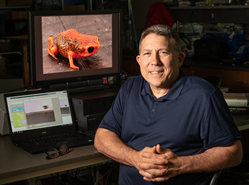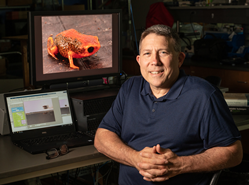
Richard Essner, PhD, professor in the SIUE College of Arts and Sciences’ Department of Biological Sciences.
EDWARDSVILLE, Ill. (PRWEB)
June 21, 2022
A small frog is making big headlines thanks to the intriguing findings of researchers, led by Southern Illinois University Edwardsville’s Richard Essner, PhD.
Comparable in size to the end of a pencil, or approximately one centimeter in length, Pumpkin Toadlets’ tiny nature, notably their semicircular canals, is making them clumsy when they jump with the inability to land gracefully, according to the researchers.
Essner, a professor in the SIUE College of Arts and Sciences’ Department of Biological Sciences, collaborated with researchers from Edge Hill University in England, Universidade Federal do Paraná in Brazil, and the Florida Museum of Natural History at the University of Florida in Gainesville.
Their work was recently published in the prestigious, open-access scholarly journal Science Advances. Now, brightly colored Pumpkin Toadlets and the researchers’ findings are taking Twitter by storm. Additionally, Science Advances’ metric measuring attention on research places the scholarship among the top 5% ever, with related headlines spanning more than nine countries.
“We discovered that this group of miniaturized frogs from Brazil, known as Pumpkin Toadlets, are unable to control their landings,” Essner said. “We think that their unusual landing behavior results from the small size of their semicircular canals, which are used to detect angular acceleration.”
Pumpkin Toadlets and other miniaturized frogs have the smallest semicircular canals known among adult vertebrates. The vestibular system of the inner ear provides essential information about balance and movement. At small size, fluid within the semicircular canals cannot flow freely because of high resistance due to friction. This causes a reduction in sensitivity to angular acceleration and impedes their ability to use vestibular feedback to control their posture in mid-air like other frogs.
During his time as a postdoctoral researcher at the University of Pennsylvania, Essner developed an interest in the jumping and landing behavior of a group of frogs known as leiopelmatids, which branched off from other frogs over 200 million years ago. At the time, most of what was known about frog locomotion was based on frog species commonly available but not evolutionarily informative. His team filmed the frogs in his lab at SIUE and determined they lacked the controlled landings of other frogs, meaning they did not fold up their hindlimbs in midair and land forelimbs-first. This provided evidence that the evolution of jumping was a two-step process with jumping appearing first and controlled landings appearing later.
“Rudá Pereira, a graduate student who worked with Dr. Marcio Pie at the Universidade Federal do Paraná, conducted his thesis research on jumping and landing behavior in a diverse array of frog species,” Essner said. “He found that Pumpkin Toadlets, were remarkably similar to leiopelmatid frogs in having uncontrolled landings.”
The findings were unexpected, though, because the toadlet is not at all closely related to leiopelmatids, and their closest relatives jump like most other frogs. This led the researchers to presume the clumsiness was due to its size rather than ancestral behavior.
“In the future, we’d like to examine jumping in other groups of miniaturized frogs and juveniles from small frogs,” explained Essner. “We’d also like to examine soft tissues associated with the vestibular system and collaborate with neurophysiologists to investigate the neural control of locomotion in miniaturized frogs.”
Because disorders of the vestibular system are common in humans, Essner asserts that having an animal model of naturally occurring vestibular dysfunction could be useful for future scientific research.
Essner earned both a bachelor’s and master’s in biology from Southeast Missouri State University in 1993 and 1996, respectively. He then earned a PhD in biological sciences from Ohio University in 2003 and joined the SIUE faculty in the fall of 2005 after completing his fellowship in Pennsylvania.
Science Advances is published by the American Association for the Advancement of Science. It showcases innovative, original research and reviews across a broad range of scientific disciplines.
Southern Illinois University Edwardsville provides students with a high-quality, affordable education that prepares them for successful careers and lives of purpose to shape a changing world. Built on the foundation of a broad-based liberal education, and enhanced by hands-on research and real-world experiences, the academic preparation SIUE students receive equips them to thrive in the global marketplace and make our communities better places to live. Situated on 2,660 acres of beautiful woodland atop the bluffs overlooking the natural beauty of the Mississippi River’s rich bottomland and only a short drive from downtown St. Louis, the SIUE campus is home to a diverse student body of more than 13,000.
Share article on social media or email:

